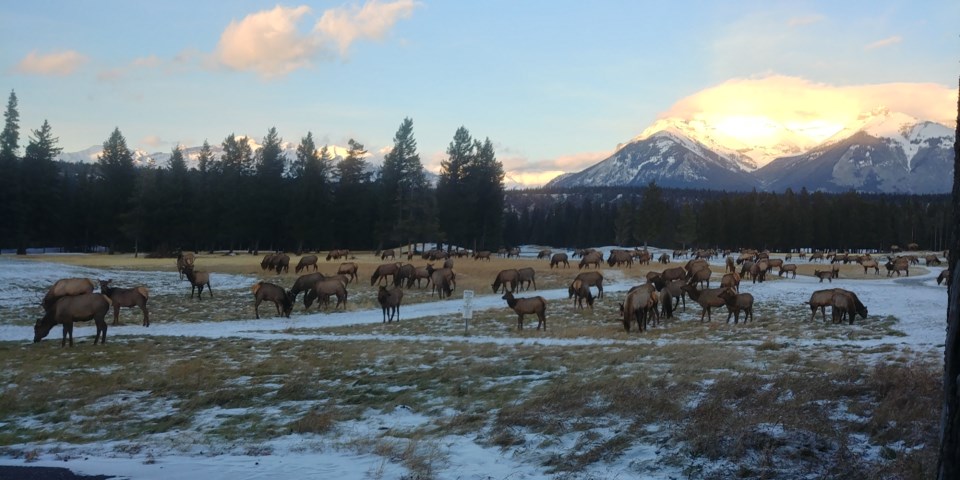BANFF – Elk numbers around the Banff townsite are slightly down this year, in part due to the successful hunting efforts of the Bow Valley wolf pack.
Parks Canada found 212 elk as part of the fall classified count in the Bow Valley between Castle Mountain and the east park gate – 129 females, 42 males, 35 young-of-year and six young male elk, also known as spike elk.
Wildlife experts say that puts the cow-calf ratio at 27 per cent compared to 35 per cent last year, indicating higher elk mortality from natural or human causes, such as the train tracks, or lower calf survival in spring due to tougher environmental conditions or lower pregnancy rates.
“Generally when you start seeing lower cow-calf ratios, it’s also kind of indicative of some kind of increase in predation,” said Blair Fyten, a human-wildlife coexistence specialist in Banff National Park.
“That predation could come from wolves, coyotes, cougars, and/or black and grizzly bears, but we see a lot of activity by the Bow Valley wolves close to the townsite.”
The Bow Valley wolf pack currently has seven members, including pups.
The pack’s extensive home range covers from the east boundary of Banff National Park near Harvie Heights west to Lake Louise and surrounding valleys in between.
However, at least one member of the wide-ranging pack – a sub-adult male fitted with a GPS collar – ventured into the Canmore area and further east to Gap Lake earlier in the fall.
“Our current Bow Valley wolf pack, they tend to come in fairly close to town,” Fyten said.
“They’ll come back in behind the rec grounds, down on the golf course, Indian grounds; they are commonly in those areas hunting.”
Fyten said Parks Canada is aware of 55 elk deaths in 2020 where carcasses were discovered or reported.
“Some are rail and potentially highway, or natural mortalities,” he said. “There’s also instances where they’ve been preyed upon by other species than just wolves.”
The fall classified count in Banff National Park has been conducted by Parks Canada since 1985. It’s a ground survey conducted over a few days by teams of Parks Canada staff.
In 2019, 249 elk were spotted during the fall survey – 150 adult female, 31 adult male, 53 young-of-year, 15 young males, for a cow-calf ratio of 35 per cent.
The year before, the cow-calf ratio was 42 per cent, with 165 adult females, 19 adult males, 70 young-of-year and 13 young male elk, for a total elk count of 267.
“For a fall count, this year’s is a little on the low end, but still within a normal range,” Fyten said.
By fall, migrating elk tend to be back in the area and most congregate in areas around the townsite in winter, such as the Banff Springs golf course, near the industrial compound and behind the commercial horse stables.
“This is where the best habitat is,” Fyten said. “They also find a little bit more security being in close to facilities and/or people to get away from predators.”
The number of aggressive elk encounters in and around the Banff townsite was 26 in 2020, compared to 30 in 2019 and 12 in 2018 – but none were deemed so serious as to warrant killing the elk involved.
Fyten said there were no contact charges, adding most incidents involved elk bluff charging at people during the spring calving season when females are protecting their calves, and in the fall rut when large bulls round up their harems to breed.
“We can see the trend’s up a little bit,” Fyten said.
“In the past when we started seeing this upward trend, we would tend to cull out some of those animals that were being aggressive, but in the last few years we haven’t.”
In the early stages of the COVID-19 pandemic in spring when the townsite and surrounding national park was closed to all but essential services, there were more elk inside the townsite boundary, leading to calves born closer to or in town.
“There weren’t very many people out and about and we ended up having to move more calves,” Fyten said, noting staff would scoop up the calves and put them in a less busy area.
Parks Canada does daily patrols to keep elk out of the townsite.
“We have our hazing program where our wildlife staff every morning first thing, and towards the end of the day, patrol the periphery of the townsite,” Fyten said. “Any elk in the townsite are hazed out.”
Read more from RMOToday.com



